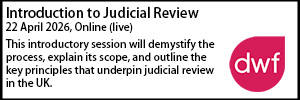Fit for the future
- Details
A consistent model of shared legal services has yet to emerge. With the majority of departments apparently now committed to shared services, albeit grudgingly in some quarters, how should it be executed? Derek Bedlow reports
 To provide answers to the question about how shared services should work in practice, in January Local Government Lawyer and Kennedy Cater hosted a roundtable of some of the leading exponents of the shared services approach, as well as a number of more sceptical participants.
To provide answers to the question about how shared services should work in practice, in January Local Government Lawyer and Kennedy Cater hosted a roundtable of some of the leading exponents of the shared services approach, as well as a number of more sceptical participants.
This included representatives from HB Law, the new shared service between the London boroughs of Harrow and Barnet, Norfolk’s NP Law, LGSS Law (Cambridgeshire and Northamptonshire county councils), the Public Law Partnership centred on Essex, and Mid Kent Legal Services.
Beating the barriers
The sheer variety of approaches to shared services was underlined by the range of models represented at the roundtable. At one end of the spectrum were those departments that have become fully integrated with other authorities’ teams. At the other, organisations such as the Public Law Partnership offer a ‘multispeed’ shared services model, with a shared practice management system and further services of which independent member authorities can choose to take advantage of or not.
As the roundtable was held under Chatham House rules, the individual responses of the participants cannot be reported. However, the themes that emerged are essential reading for any department in, or considering, the shared services model.
All of the perceived barriers to shared services identified by our survey respondents have been experienced by participants in the roundtable. Chief among these were the perception that operating from a shared service structure would introduce a gap between the legal team and the members and officers they serve. Legal departments, it is argued, should be part of the decision-making process, rather than the rubber stamp at the end. In a number of integrated shared services teams, this problem has been mitigated to some degree by leaving a lawyer behind after the legal team has migrated to the off-site shared service.
However, creating more of a gap between the legal team and the authority was not viewed as an entirely bad thing by some, given many clients’ over-reliance on the legal department which some respondents identified as creating an additional burden on legal teams. “There will be a degree of separation and we need to think about how we deliver the service that clients want when lawyers are a scarce resource,” said one head of legal.
Trading your way out of trouble
The vast majority of shared services teams operate a traded services model which, they say, helps to overcome the second biggest perceived barrier identified by survey respondents – being able to demonstrate the financial benefit of shared services.
Few among the participants were inclined to disagree with the survey’s findings in this regard. “We have to be able to prove that it works,” said one head of legal. “It’s almost like Compulsory Competitive Tendering (CCT) all over again.”
Operating a traded services model, many at the roundtable agreed, also has the advantage for some of providing objective justification for further recruitment (or at least avoiding job cuts) and it was also generally accepted that any other formula for divvying up the cost of the legal team between two or more authorities would be too complex to work in practice.
To a large degree, however, operating a traded service is more frequently seen as a prerequisite for setting up shared services rather than the other way around. When asked to list the main drivers to enter into shared services, a relatively small proportion (32%) said that it would provide a better platform for the selling of legal services to other public bodies and possibly beyond.
Yet one key driver for many of the shared services teams represented in the room was to create the capacity and resilience necessary to provide legal services beyond their parent authorities. When developing a shared services model, account needs to be taken not only of current conditions, but also of the ‘market’ for local authority legal services in the foreseeable future.
I want to break free?
There was considerable concern that by standing still, local authority legal departments risked being subjected to death by a thousand cuts as a toxic brew of outsourcing, austerity and possible local government reorganisation sees the client base of many legal teams eroded over time.
This is already becoming apparent at some councils, where one respondent to the survey described his department’s biggest challenge as being: “redefining the role of the legal department in the context of the authority becoming a commissioning organisation”.
The longer term aim of many shared services operations, therefore, is to get themselves into position to continue to have a role in what may well be a much more diverse ‘market’ in the years to come. Some see that local authority legal teams will be in competition with private practice law firms and perhaps other outsourced private sector legal providers for a variety of public sector, not-for-profit and mutual and privately-owned organisations.
The SRA’s recent decision to allow local authority legal teams to provide legal advice to charitable organisations may prove to have significant benefits beyond just winning academy schools as clients if the government’s plans for the growth of social enterprises and other alternative service delivery vehicles finally bear fruit.
In this scenario, the ability to provide a flatter, cheaper structure than the partnership model still adopted by private practice firms, would potentially put local authority-derived teams in a strong position, but the exponents of this approach agreed that there remains much work to do in terms of customer service, marketing and capacity building if they are to properly compete.
Opinion was divided about whether the alternative business structure (ABS) represented the best route to reach this goal, at least for now. For some, a key advantage of taking the ABS route was the arm’s length relationship this would create with the host council(s).
Potentially, this would enable the legal team to grow and develop in line with demand for its services, with the flexibility to recruit on its own terms, outside of any pay structures or hiring freezes at the originating authority. Remaining within the Teckal exemption may prove challenging though.
For others, however, opening such a gap between the original authority and the legal team ran the risk of leaving the legal team adrift as and when the authority re-tendered its contracts for legal services. These risks were exacerbated, it was also argued, by the current regulatory uncertainty around whom local authority teams would be able to act for in future. There were also question marks over whether an ABS would need private funding to reach the critical mass required, thereby breaking the Teckal exemption and forcing the legal team to re-tender.
Deputy Director Legal and Democratic Services
Solicitor/Lawyer (Contracts and Procurement)
Lawyer (Planning and Regulatory)
Legal Director - Government and Public Sector
Regulatory/Litigation Lawyer
Antisocial Behaviour Legal Officer
Solicitor - Litigation
Legal Adviser
Contracts Lawyer
Governance Lawyer
Locum roles
 Masterclass – MCA and Court of Protection - Legal Update - Peter Edwards Law Training
Masterclass – MCA and Court of Protection - Legal Update - Peter Edwards Law Training
21-01-2026
Online (live)
 Managing settlements: the legal and practical issues, and the pitfalls to avoid - Blake Morgan
Managing settlements: the legal and practical issues, and the pitfalls to avoid - Blake Morgan
22-01-2026 10:00 am
Online (live)
 Children and Young People (DoL, Competency and Capacity) - Peter Edwards Law Training
Children and Young People (DoL, Competency and Capacity) - Peter Edwards Law Training
28-01-2026
Online (live)
 HMPL Building Blocks: Legal Tools to Combat Anti-Social Behaviour - Devonshires
HMPL Building Blocks: Legal Tools to Combat Anti-Social Behaviour - Devonshires
17-02-2026
Online (live)
 Freedom of thought, belief and religion: Article 9 ECHR - Francis Taylor Building
Freedom of thought, belief and religion: Article 9 ECHR - Francis Taylor Building
19-02-2026
Online (live)
 Grappling with S73 - variations of conditions applications or appeals - Ivy Legal
Grappling with S73 - variations of conditions applications or appeals - Ivy Legal
09-03-2026
Online (live)
 HMPL Building Blocks: Tenancy Management – Assignment, Mutual Exchange and Succession - Devonshires
HMPL Building Blocks: Tenancy Management – Assignment, Mutual Exchange and Succession - Devonshires
12-03-2026
Online (live)
 Section 31(2A) Senior Courts Act: where have we got to? - Francis Taylor Building
Section 31(2A) Senior Courts Act: where have we got to? - Francis Taylor Building
18-03-2026 1:00 pm
Online (live)
 Save the Date: The Law of Public Rights of Way, Commons and Town or Village Greens Seminar (Hybrid) - Francis Taylor Building
Save the Date: The Law of Public Rights of Way, Commons and Town or Village Greens Seminar (Hybrid) - Francis Taylor Building
25-03-2026
London
 HMPL Building Blocks: A Housing Officer’s Guide to Court Proceedings - Devonshires
HMPL Building Blocks: A Housing Officer’s Guide to Court Proceedings - Devonshires
14-04-2026
Online (live)




























































































































 First Aid Level 3 - LBL Skills
First Aid Level 3 - LBL Skills  Capsticks Housing Diploma
Capsticks Housing Diploma  Standish 18 months on - 42BR
Standish 18 months on - 42BR  Accelerating EV Charging Infrastructure in the Public Sector - DWF
Accelerating EV Charging Infrastructure in the Public Sector - DWF  Building Safety Act Conference 2026 - Landmark Chambers
Building Safety Act Conference 2026 - Landmark Chambers  Education Law Conference - 3PB
Education Law Conference - 3PB  Annual Planning Seminar 2026 - No.5 Barristers
Annual Planning Seminar 2026 - No.5 Barristers 